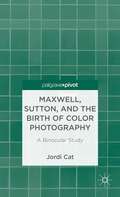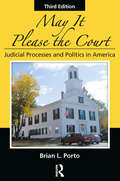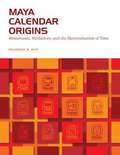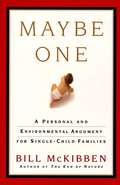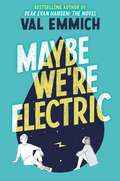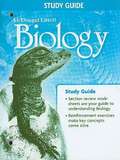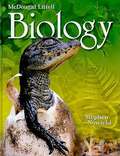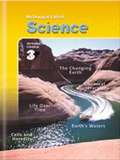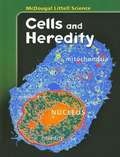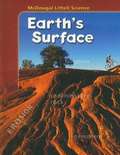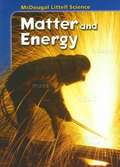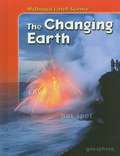- Table View
- List View
Maxwell's Enduring Legacy
by Malcolm LongairThe Cavendish Laboratory is arguably the most famous physics laboratory in the world. Founded in 1874, it rapidly gained a leading international reputation through the researches of the Cavendish professors beginning with Maxwell, Rayleigh, J. J. Thomson, Rutherford and Bragg. Its name will always be associated with the discoveries of the electron, the neutron, the structure of the DNA molecule and pulsars, but these are simply the tip of the iceberg of outstanding science. The physics carried out in the laboratory is the central theme of the book and this is explained in reasonably non-technical terms. The research activities are set in their international context. Generously illustrated, with many pictures of the apparatus used and diagrams from the original papers, the story is brought right up to date with descriptions of the science carried out under the leadership of the very different personalities of Mott, Pippard and Edwards.
Maxwell, Sutton and the Birth of Color Photography: A Binocular Study
by Jordi CatThis focused and incisive study reassesses the historic collaboration between James Clerk Maxwell and Thomas Sutton. It reveals that Maxwell and Sutton were closer to true partners than has commonly been assumed, and shows how their experiments illuminate the role of technology, representation, and participation in Maxwell's natural philosophy.
May It Please the Court, Third Edition: Judicial Processes and Politics In America
by Brian L. PortoThis practical, comprehensive, and engaging introduction to the American judicial system is designed primarily for undergraduate students in criminal justice, liberal arts, political science, and beginning law. It differs from other texts not only by delivering an insider’s view of the courts, but also by demonstrating how the judicial process operates at the intersection of law and politics. Unlike the many dull and inaccessible texts in this field, May It Please The Court conveys the human drama of civil and criminal litigation. With an updated epilogue, case studies, and discussion questions, this third edition is a robust resource for criminal justice students.
Maya Calendar Origins: Monuments, Mythistory, and the Materialization of Time
by Prudence M. RiceIn Maya Political Science: Time, Astronomy, and the Cosmos, Prudence M. Rice proposed a new model of Maya political organization in which geopolitical seats of power rotated according to a 256-year calendar cycle known as the May. <P><P>This fundamental connection between timekeeping and Maya political organization sparked Rice's interest in the origins of the two major calendars used by the ancient lowland Maya, one 260 days long, and the other having 365 days. In Maya Calendar Origins, she presents a provocative new thesis about the origins and development of the calendrical system. Integrating data from anthropology, archaeology, art history, astronomy, ethnohistory, myth, and linguistics, Rice argues that the Maya calendars developed about a millennium earlier than commonly thought, around 1200 BC, as an outgrowth of observations of the natural phenomena that scheduled the movements of late Archaic hunter-gatherer-collectors throughout what became Mesoamerica. She asserts that an understanding of the cycles of weather and celestial movements became the basis of power for early rulers, who could thereby claim "control" over supernatural cosmic forces. Rice shows how time became materialized--transformed into status objects such as monuments that encoded calendrical or temporal concerns--as well as politicized, becoming the foundation for societal order, political legitimization, and wealth. Rice's research also sheds new light on the origins of the Popol Vuh, which, Rice believes, encodes the history of the development of the Mesoamerican calendars. She also explores the connections between the Maya and early Olmec and Izapan cultures in the Isthmian region, who shared with the Maya the cosmovision and ideology incorporated into the calendrical systems.
Maybe It's Me: On Being the Wrong Kind of Woman
by Eileen PollackScientist and author of The Only Woman in the Room explores her intelligence up against social inequality in this collection of personal essays.Eileen Pollack has always had a love-hate relationship with society&’s rules for women and girls—especially as they were laid out for her while growing up in 1960s upstate New York. In Maybe It&’s Me, she recounts her many trials, triumphs, and misadventures as a smart woman navigating a world that is only just learning to imagine equality between the sexes.With poignant humor and candid honesty, Pollack describes her journey from high school—where she wasn&’t allowed to take advanced courses in science or math because she was female—to earning a physics degree at Yale; a post-graduate summer in which she was shot at and kidnapped; and a theoretically equal marriage in which she was nonetheless expected to do all the housework and child-rearing, pay the taxes, and make sure the Roto-Rooter guy arrived on time. &“Maybe it&’s me&” is a thought all women have struggled with at one time or another. Pollack&’s autobiographical essays take us from intimate, humorous stories of innocent curiosity to the calculated meanness of tween girls, from the defensive strategies of threatened men to incisive examinations of how society got here. In the end, Pollack&’s message is one of human connection and tenacity along the unending search for love, acceptance, and equality.
Maybe One
by Bill MckibbenFrom the groundbreaking, bestselling author of The End of Nature, a controversial and provocative book arguing that to help the planet we should begin to voluntarily limit our numbers. Bill McKibben's books and essays on our environment -- physical and spiritual -- have shaped and spurred debate since The End of Nature was published in 1989. Then, he sounded one of the earliest alarms about global warming; the decade of science since has proved his prescience. Now, in Maybe One, he takes on the most controversial of environmental problems -- population. We live in a unique and dangerous time, he asserts, when the planet's limits are being tested and voluntary reductions in American childbearing could make a crucial difference. The father of a single child himself, McKibben maintains that bringing one, and no more than one, child into this world will hurt neither your family nor our nation -- indeed, it can be an optimistic step toward the future. Maybe One is not just an environmental argument but a highly personal and philosophical one. McKibben cites new and extensive research about the developmental strengths of only children; he finds that single kids are not spoiled, weird, selfish, or asocial, but pretty much the same as everyone else. McKibben recognizes that the transition to a stable population size won't be easy or pain-free but ultimately is inevitable. Maybe One provides the basis for provocative, powerful thought and discussion that will influence our thinking for decades to come.
Maybe We're Electric
by Val EmmichFrom Val Emmich, the bestselling author of Dear Evan Hansen: The Novel, comes a deeply affecting story of two teens who find themselves thrown together overnight during a snowstorm and discover a surprising connection—perfect for fans of Nina LaCour, David Arnold, and Robin Benway.Tegan Everly is quiet. Known around school simply as the girl with the hand, she's usually only her most outspoken self with her friend Neel, and right now they're not exactly talking. When Tegan is ambushed by her mom with a truth she can't face, she flees home in a snowstorm, finding refuge at a forgotten local attraction—the tiny Thomas Edison museum.She's not alone for long. In walks Mac Durant. Striking, magnetic, a gifted athlete, Mac Durant is the classmate adored by all. Tegan can't stand him. Even his name sounds fake. Except the Mac Durant she thinks she knows isn't the one before her now—this Mac is rattled and asking her for help.Over one unforgettable night spent consuming antique records and corner-shop provisions, Tegan and Mac cast aside their public personas and family pressures long enough to forge an unexpectedly charged bond and—in the very spot in New Jersey that inspired Edison's boldest creations—totally reinvent themselves. But could Tegan's most shameful secret destroy what they've built?Emotionally vivid and endlessly charming, Maybe We're Electric is an artfully woven meditation on how pain can connect us—we can carry it alone in darkness or share the burden and watch the world light up again.
McCrae's Battalion: The Story of the 16th Royal Scots
by Jack AlexanderMcCrae's Own was the 'Heart of Midlothian Battalion' mentioned all too briefly in Martin Middlebrook's classic book The First Day on the Somme. Raised in Edinburgh shortly after the start of the Great War, it was perhaps the finest unit in Lord Kitchener's volunteer army - a brotherhood of sportsmen, bound together by their extraordinary colonel and their loyalty to a quaintly named Association Football club, the famous Gorgie 'Hearts'. McCrae's were blooded in the Battle of the Somme, losing three-quarters of their strength on the first day alone. The Colonel himself was invalided home. In time the battalion recovered. It came of age at Arras, endured the muddy horror of Passchendaele, and held the line unbroken in the face of furious German attacks on the Lys in 1918. For almost a century their story remained untold. It was all but lost forever. Now, after 12 years of exacting historical detective work, Jack Alexander has reclaimed the 16th Royal Scots for posterity. In this stirring book he draws upon interviews with veterans and a unique archive of letters, diaries and photographs, assembled from the families of more than 1,000 of Sir George McCrae's men.
McDougal Littell Biology (Pennsylvania Edition)
by Stephen NowickiThis Pennsylvania edition of McDougal Littell Biology contains unit lessons on Biology, Cells, Genetics, Evolution, Ecology, Classification and Diversity, Plants, Animals, and Human Biology.
McDougal Littell Biology: 2008
by Stephen NowickiThis textbook serves as the centerpiece of the new McDougal Littell Biology program. Through graphic photos and illustrations, memorable connections, and lab activities in every chapter, McDougal Littell brings Biology into the world of a student. It provides students with a structured framework of key concepts and main ideas upon which to build their knowledge of biology. Critical thinking and problem solving activities help to teach students how to think in a scientific way.
McDougal Littell Science (North Carolina Edition, Grade Seven)
by The Editors at the McDougal LittellThis book is a comprehensive text on Middle school science with relevant topics like Cells and Heredity,Human Biology,Motion and Forces.
McDougal Littell Science California: Focus on Earth Science InterActive Reader
by Mcdougal LittellThe Interactive Reader makes reading science exciting, fun and easier to understand. Before each chapter, The Big Idea helps students to understand what the chapter will be about.
McDougal Littell Science Grade 8 (North Carolina Edition)
by Mcdougal LittelA science book that introduces the young future scientist to the systematic study of the nature from molecular particles to the human body to the whole universe. it's divided science into different fields: Life science Earth science Physical science
McDougal Littell Science Integrated Course 3
by The Editors at the McDougal LittellThe Changing Earth Chemical Interactions Life Over Time Cells and Heredity Earth’s Waters
McDougal Littell Science, Course 1: Integrated Course (Grade 6, North Carolina Edition)
by Rita Ann Calvo Kenneth Cutler James TrefilScience textbook for North Carolina 6th graders.
McDougal Littell Science: Cells and Heredity
by Rita Ann Calvo Kenneth Cutler James TrefilScientists are curious. Since ancient times, they have been asking and answering questions about the world around them. Scientists are also very suspicious of the answers they get. They carefully collect evidence and test their answers many times before accepting an idea as correct.
McDougal Littell Science: Earth’s Surface
by Mcdougal LittellScientists are curious. Since ancient times, they have been asking and answering questions about the world around them. Scientists are also very suspicious of the answers they get.
McDougal Littell Science: Grade 6 (Oklahoma Edition)
by Mcdougal LittellScientists are curious. Since ancient times, they have been asking and answering questions about the world around them. Scientists are also very suspicious of the answers they get. They carefully collect evidence and test their answers many times before accepting an idea as correct.In this book you will see how scientific knowledge keeps growing and changing as scientists ask new questions and rethink what was known before.
McDougal Littell Science: Grade 8 (Oklahoma Edition)
by Mcdougal LittellThis textbook contains lessons on Motion and Forces, Waves, Sound, and Light, Chemical Interactions, Earth's Surface, The Changing Earth and Life Over Time and includes Scientific Thinking Handbook, Lab Handbook, Math Handbook and Note-Taking Handbook, etc.
McDougal Littell Science: Grade Six (South Carolina Edition)
by Mcdougal LittellMcDougal Littell Science pulls together units from the different categories of science to give you a broad picture of how scientists study nature. For example, life scientists, earth scientists, and physical scientists might all study water, but from different points of view.
McDougal Littell Science: The Changing Earth (Grades 6-8)
by Mcdougal LittellIn this book you will see how scientific knowledge keeps growing and changing as scientists ask new questions and rethink what was known before. The text and pictures in this book will help you learn key concepts and important facts about earth science. A variety of activities will help you investigate these concepts.
McDougal Littell World Geography
by Marci Smith Deal Daniel D. Arreola James F. Petersen Rickie SandersThe earth is a unique planet capable of supporting a wide variety of life forms. Human beings adapt and alter the environments on earth.

